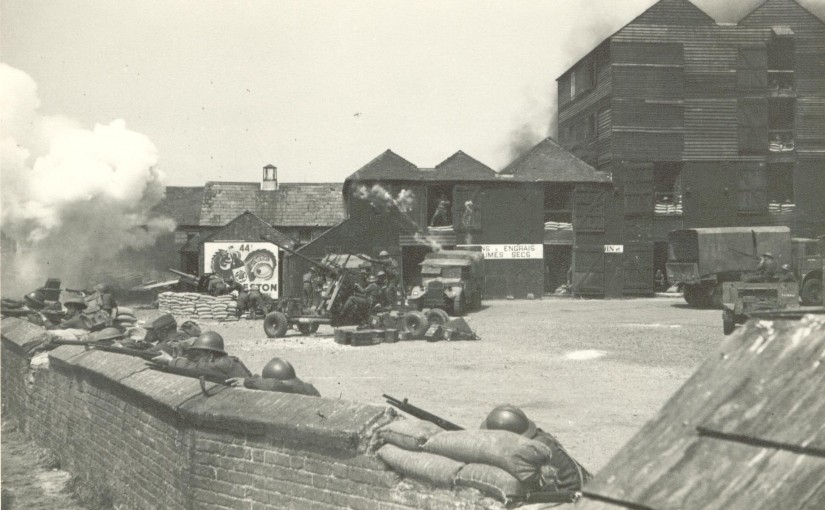One of the Best War Films Ever Made
One of the best and most realistic war films ever made was created in and around Rye. ‘Dunkirk’, made in 1957, recorded the epic evacuation of the British Expeditionary Force from the open beaches of Dunkirk in 1940. Rye was chosen for the film’s location because the beaches and area around the real Dunkirk had become too populated in the seventeen year period that had elapsed since that time.
£250,000 Production
Sir Michael Balcon produced the £250,000 film which was directed by by Leslie Norman. Among the stars taking part were John Mills, Dirk Bogart and Merridith Edwards. Joining the cast were hundreds of extras from Rye and district and 4,000 troops from the third infantry division of the British Army.
The Strand Quay was transformed into a section of the Dunkirk docks area. Appropriate French signs and advertising hoardings were erected, John Hatter provided prewar cars and vans which were painted with French business names, local farmers provided horses and carts for the ‘refugees’. A large quantity of timber was purchased from Hinds Timber Yard and a bridge was erected over the river.
Extras were paid fifteen shillings a day or thirty shillings if the went into the sea at Camber ‘over the knees’. A small group of Rye men dressed as British Tomies earned £5 on one occasion for jumping into the water at The Strand.
The ‘rearguard’ was located in and around the warehouses on the Strand and a furious battle, using blanks and smoke bombs, was fought out with the Germans.
At Camber 4,000 troops were massed on the beaches, some wading out into the sea to be picked up by fishing boats and other small vessels who would be ferrying the men out to the larger navel vessels that would carry them back to England. The fishing boats and small motor cruisers were mainly Rye boats that were hired, with their crews, to perform this tricky task. It was hard enough in peacetime with only imitation bombs exploding, it must have been a nightmare for those that were present for the real thing.
Besides the main film unit that covered the action at Camber, there was a second unit doing other scenes. A Cinema was set up at the Drill Hall off Ferry Road and other sets filmed by the second unit were skirmishes with the Germans at Wick Farm Udimore, troops at a River position filmed along the Military Canal on the Appledore Road and refugees being bombed by the Luffwaffe on the Denge Marsh road.
Extras took different parts each day and could be Tomies in the morning and German troopers in the afternoon. Some Rye extras were called on to be French soldiers, Belgian Soldiers and even refugees. Shooting in the Rye and Camber area lasted six weeks through May and into June. It was a good job and employed all the casual workers in the area. Many retired people and housewives were co-opted. The pay was good for the times, lunch was provided at a mobile canteen and the weather throughout the period was excellent. The work was far from hard, where else could a days wages be earned lying on Camber Sands in the sun? The film was a box office success and is still popular now when it appears on television.
It is nearly forty-four years since Rye was ‘invaded’ by ‘Dunkirk’ and coming up to sixty-one years on from the actual evacuation but still it is remembered with pride by those that lived through those times. Dunkirk was a defeat turned into a victory and the film was a celebration of a moment in time when the actual survival of the British Army and the outcome of the War was in the balance. It is easy for those that were not born then to enjoy a life of peace and prosperity and forget the sacrifices in lives and blood that took place in those far off days. It is good that films such as ‘Dunkirk’ are still around to jog the memory and portray our history, for is it not written that if the past is forgotten it always repeats itself?
With many thanks to Sylvia Wilgoss who provided the picture from her photo album.
Rye’s Own would be interested in any material linking Rye with the Dunkirk evacuation of 1940.
